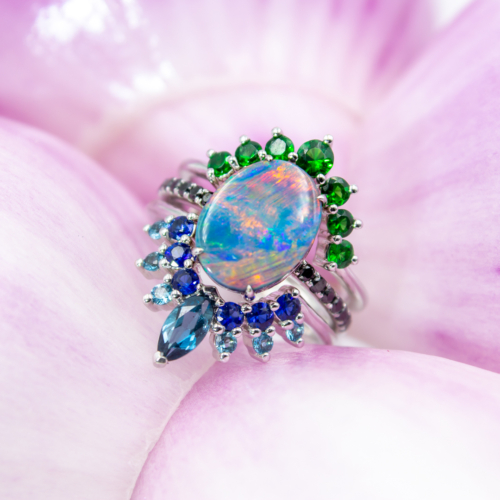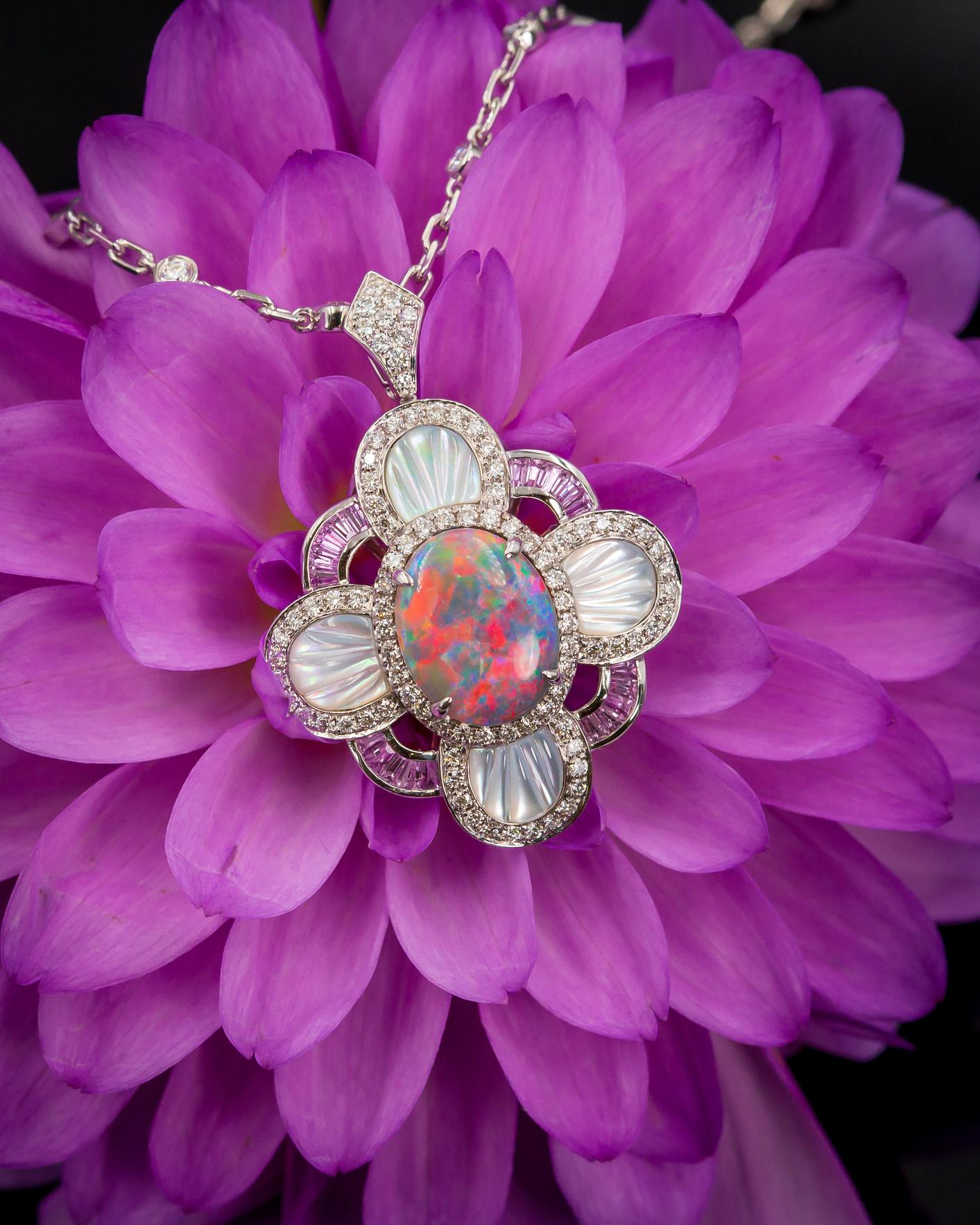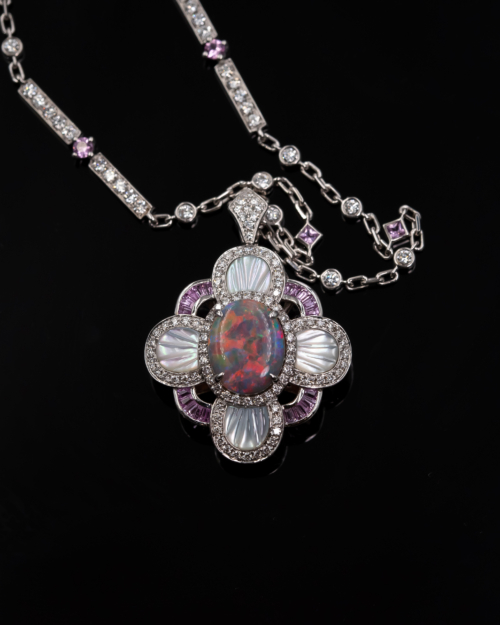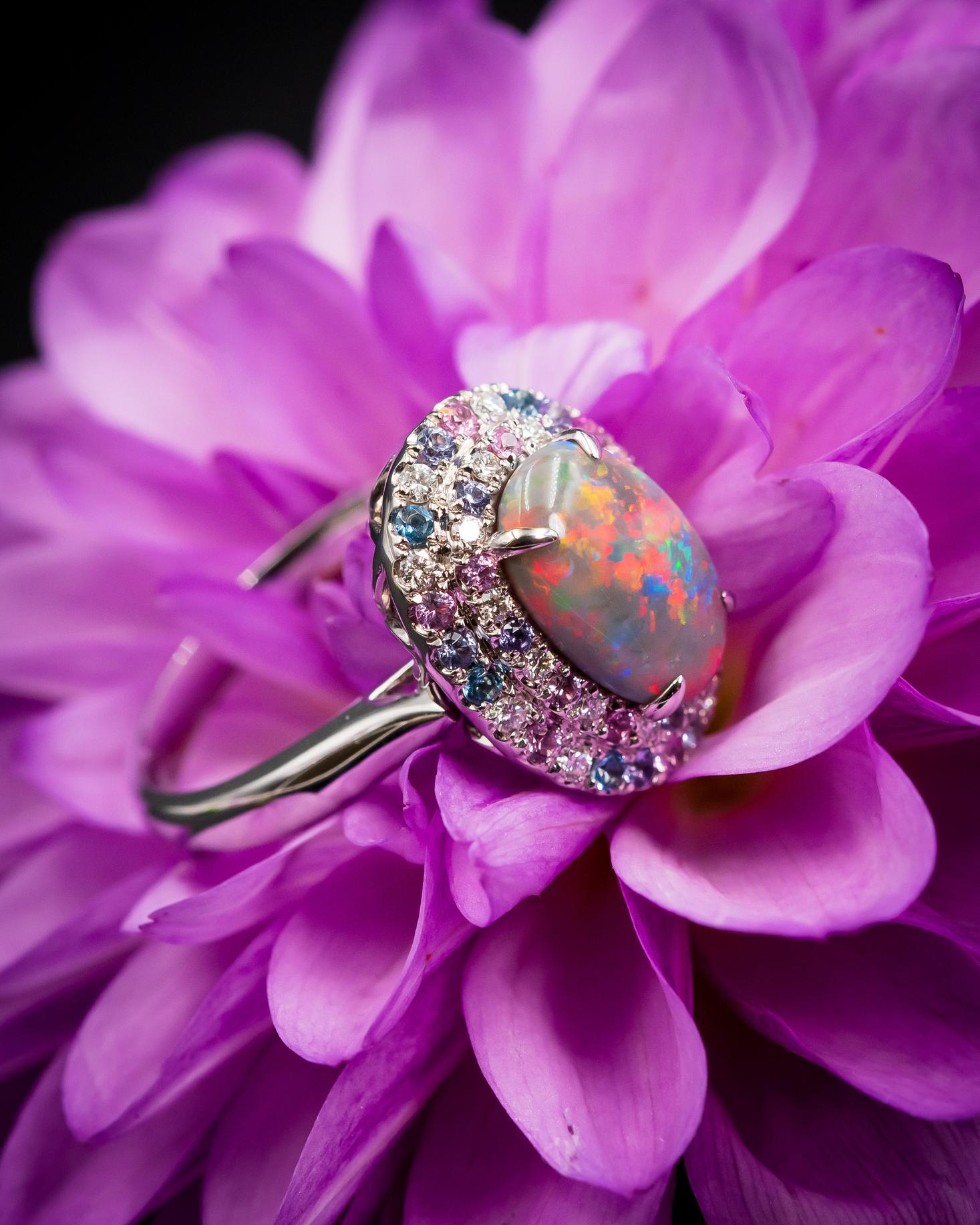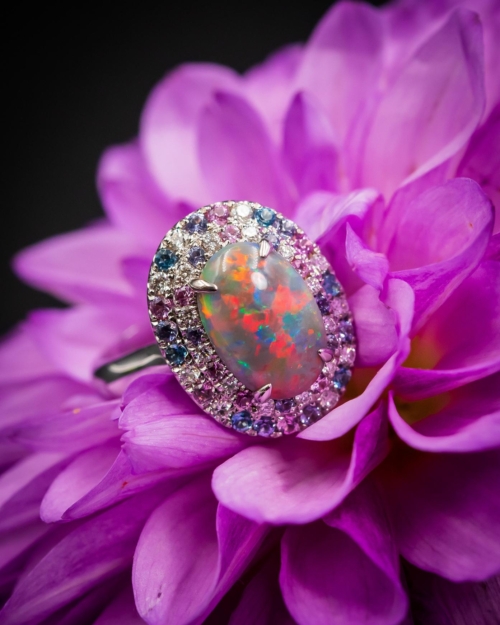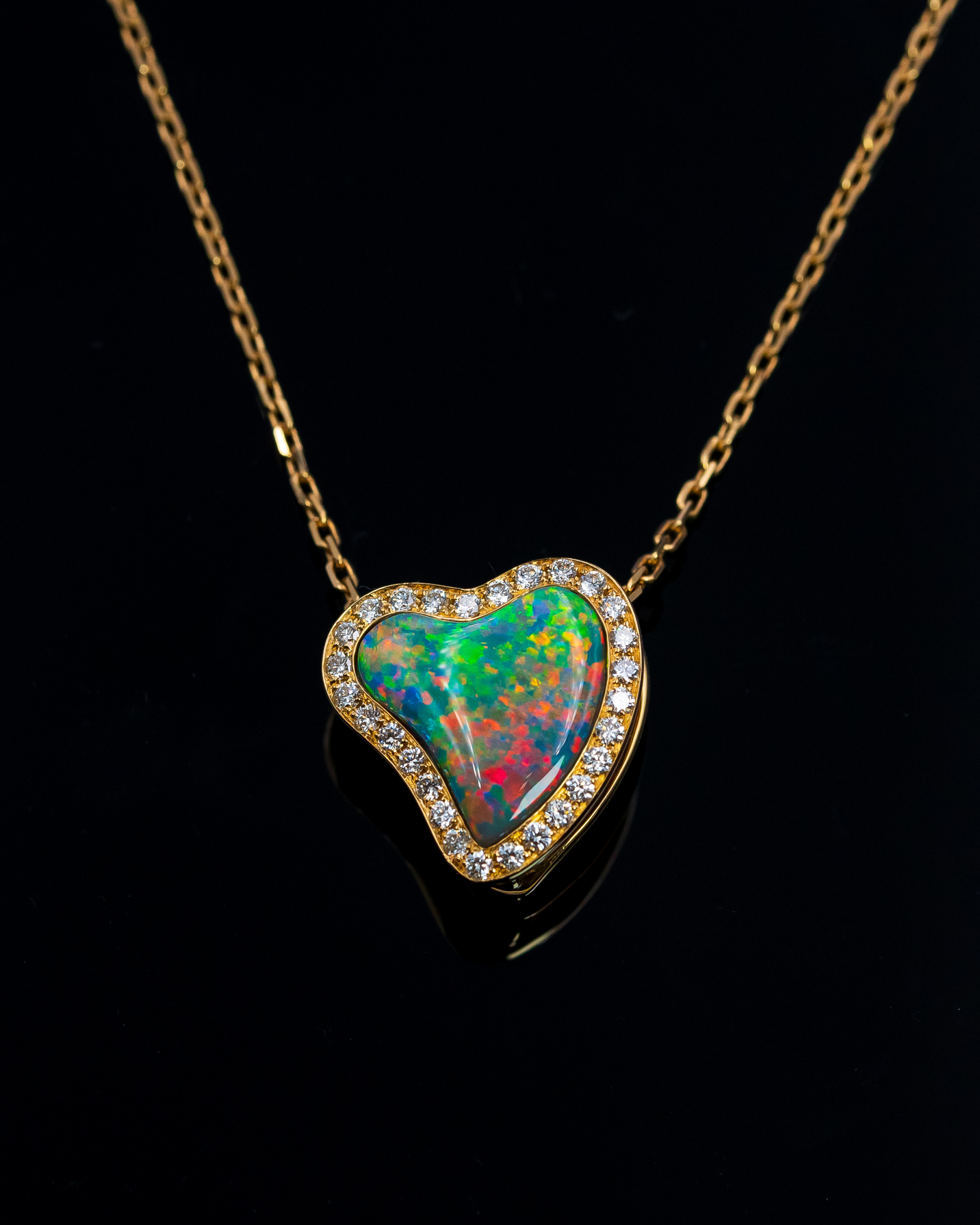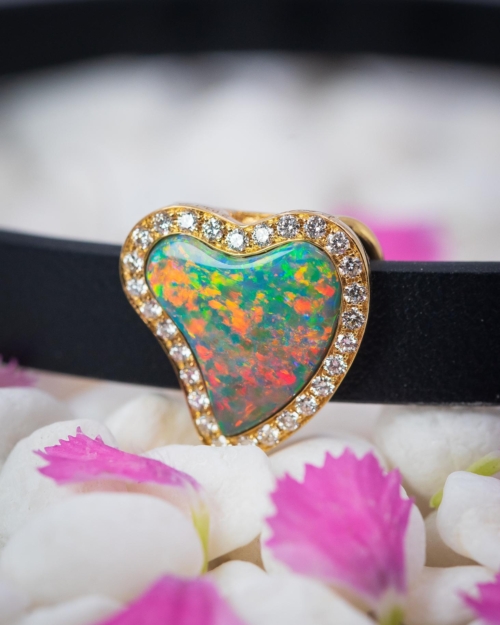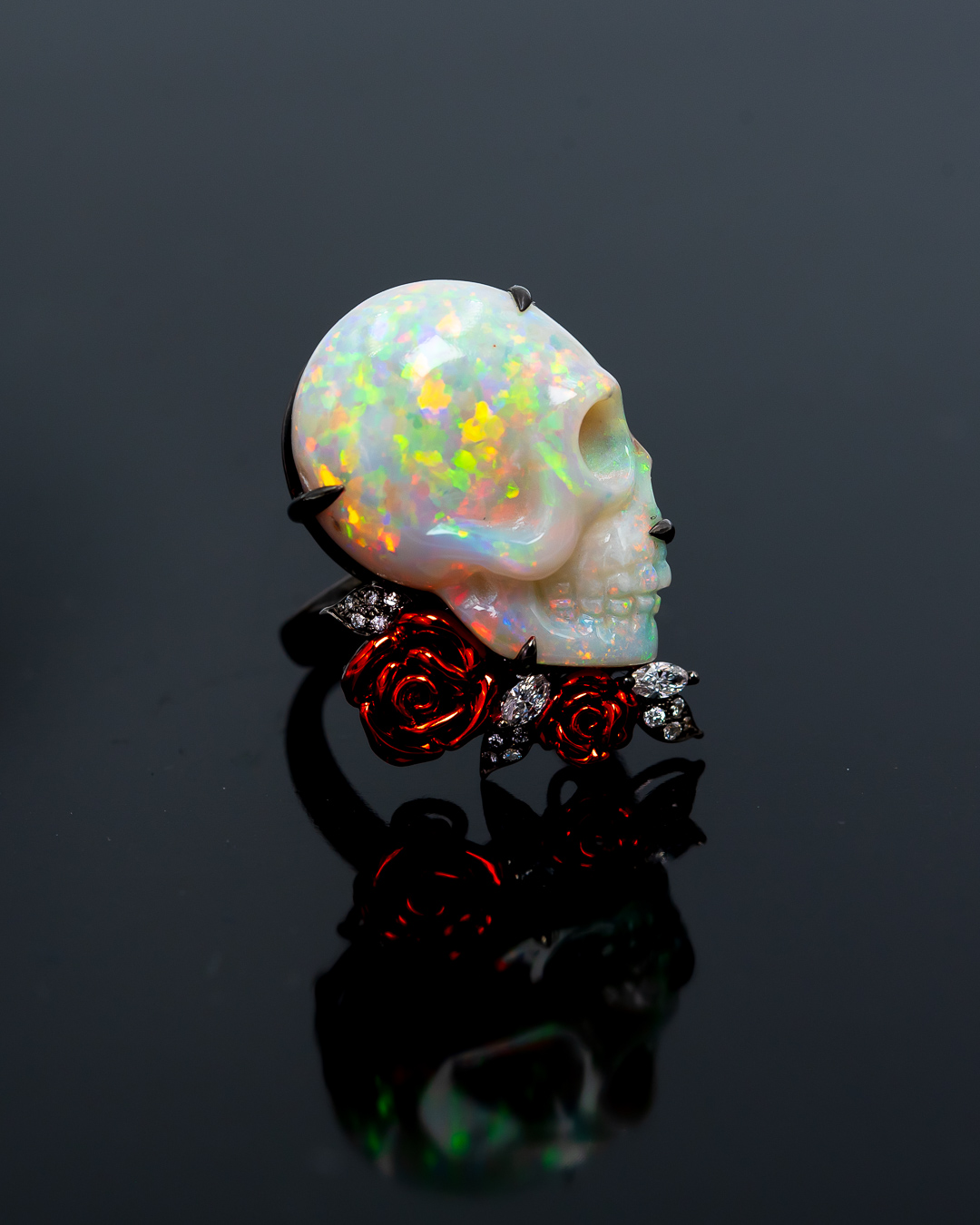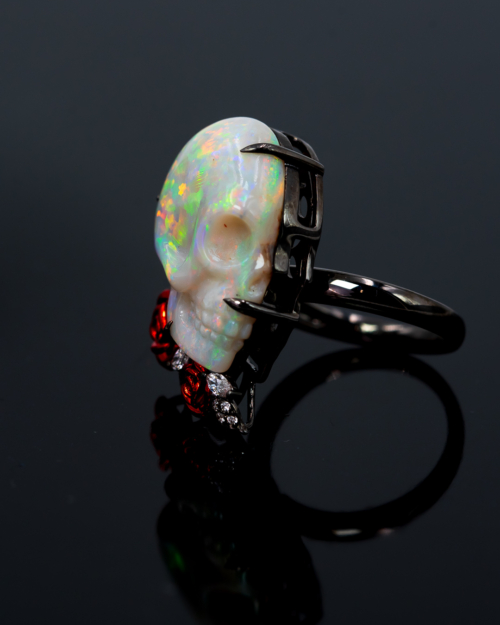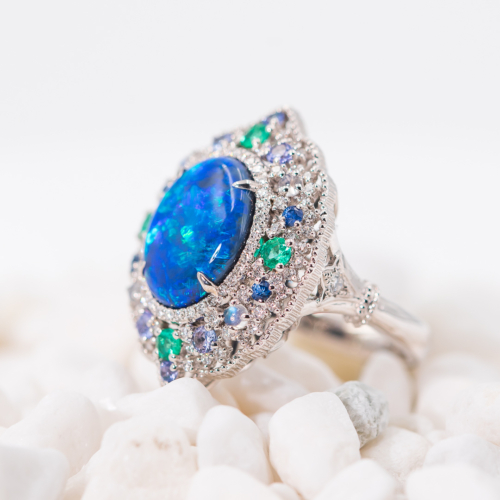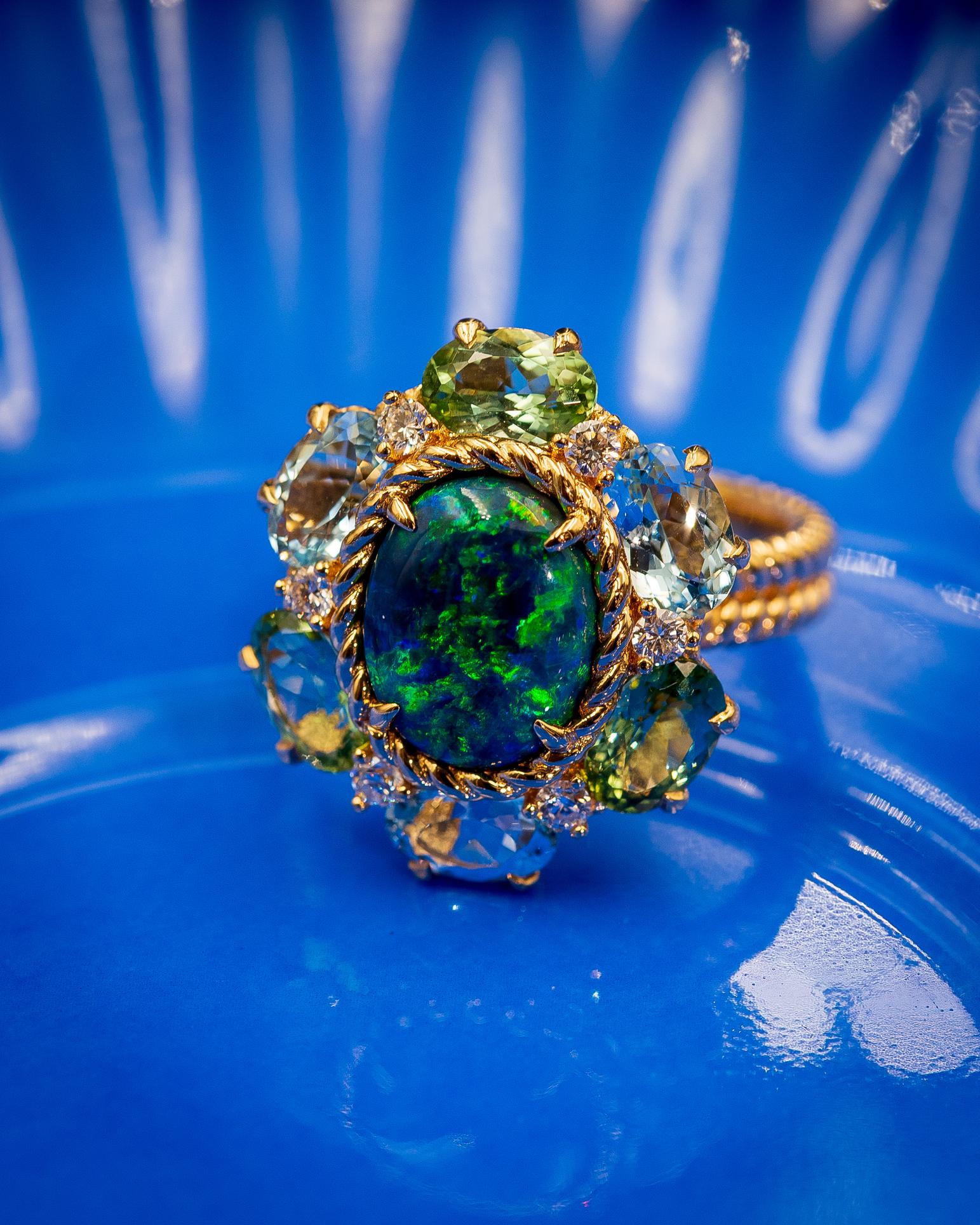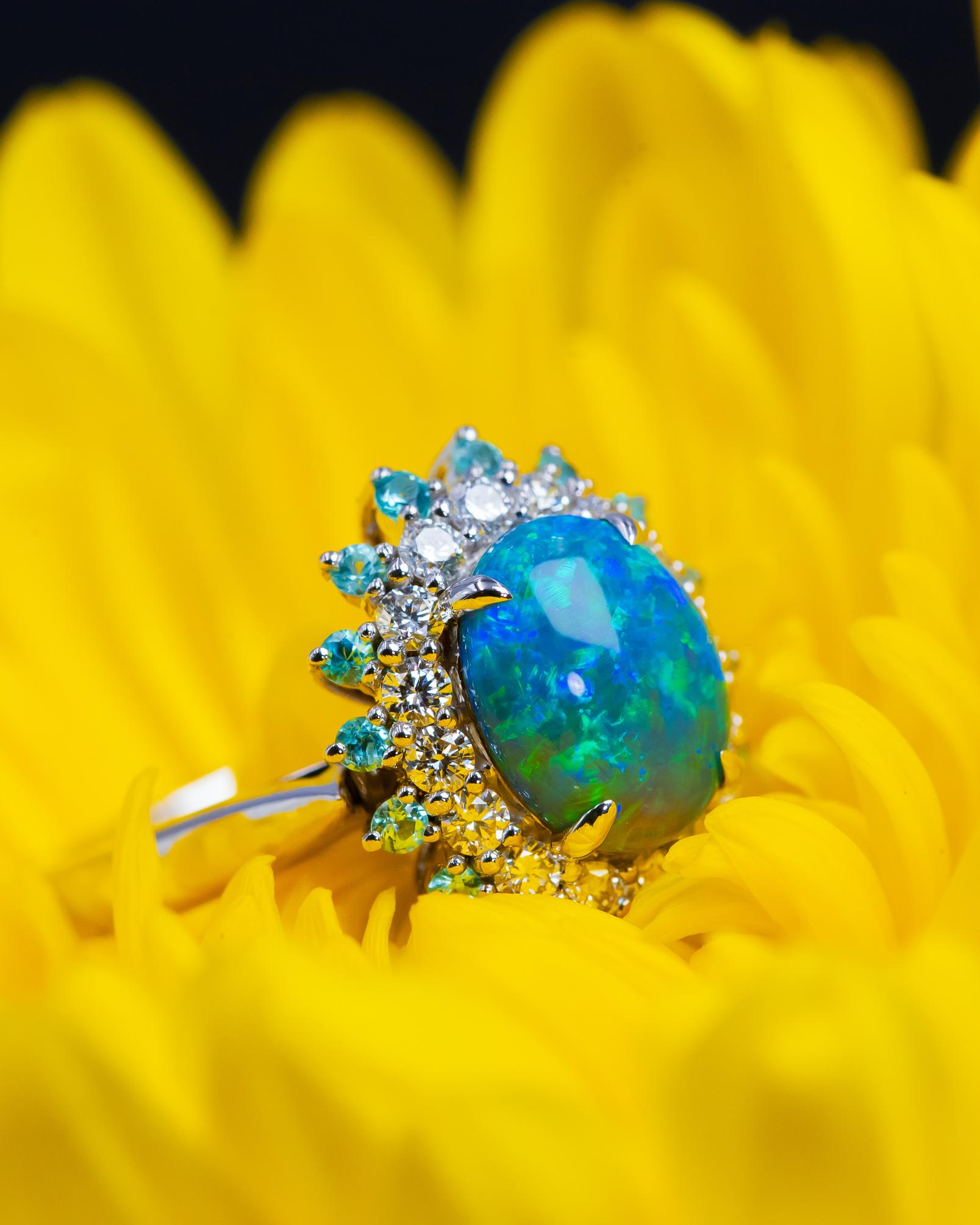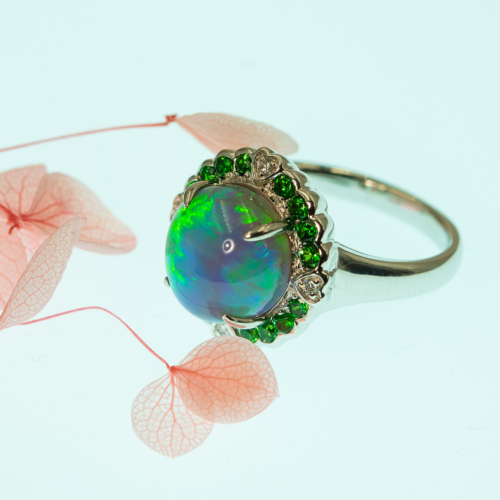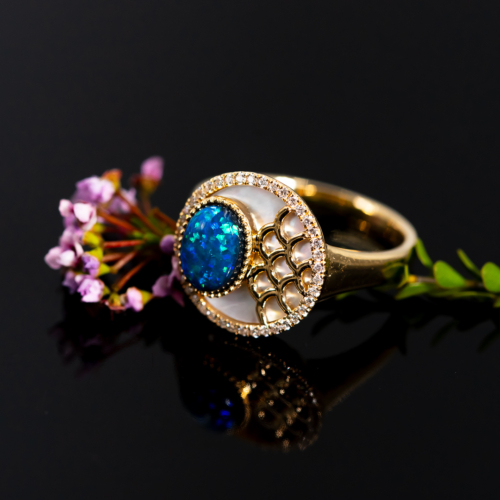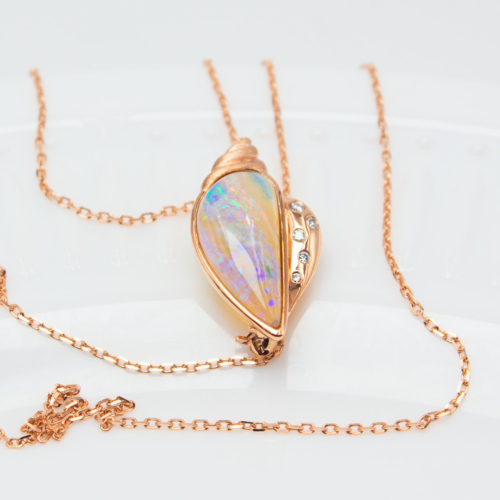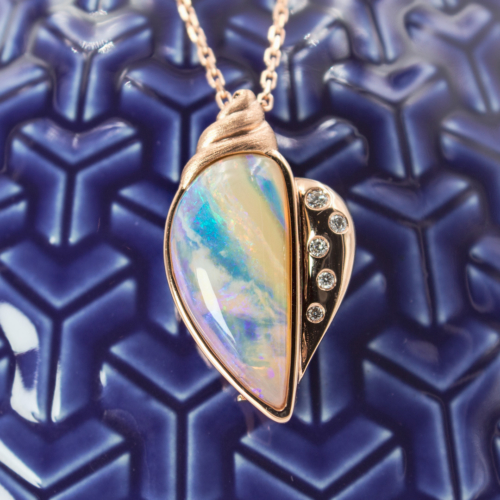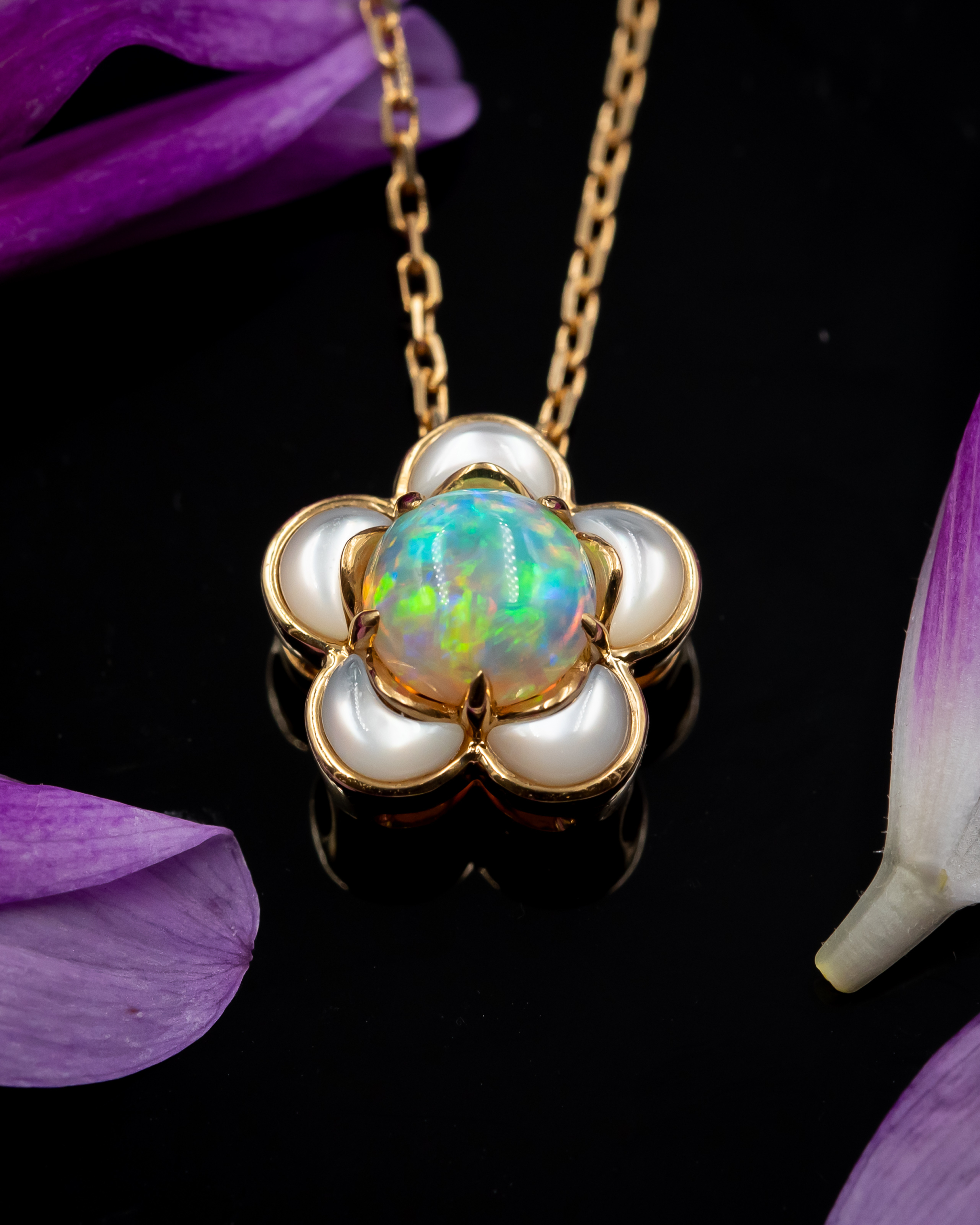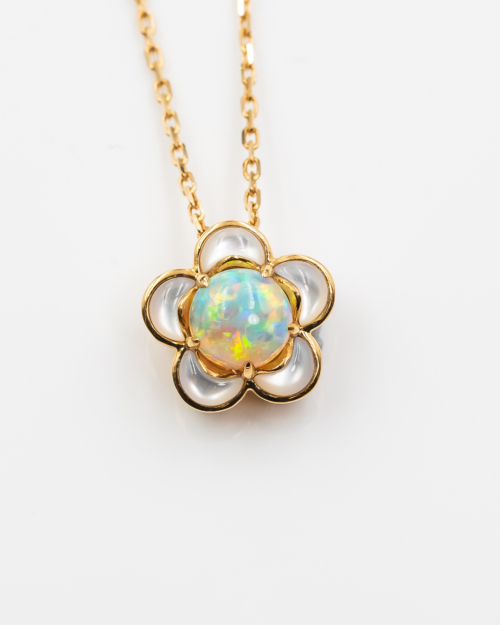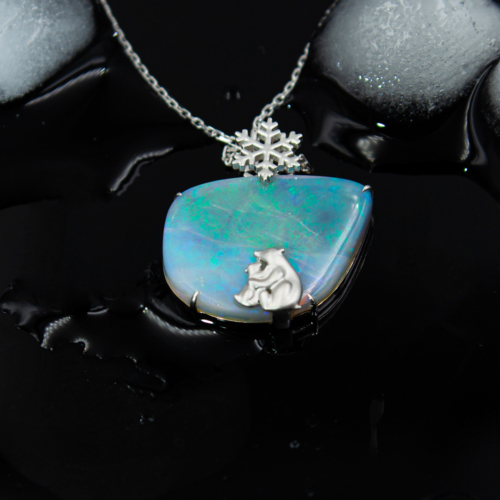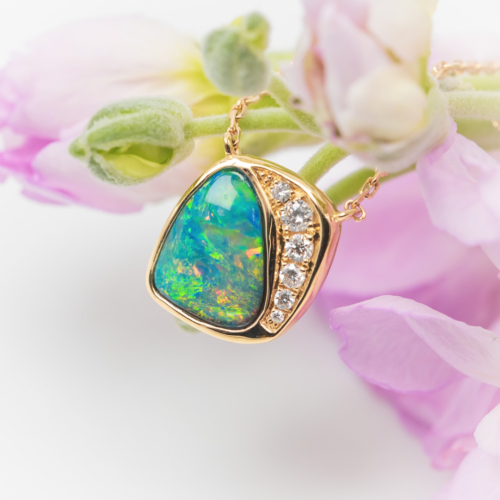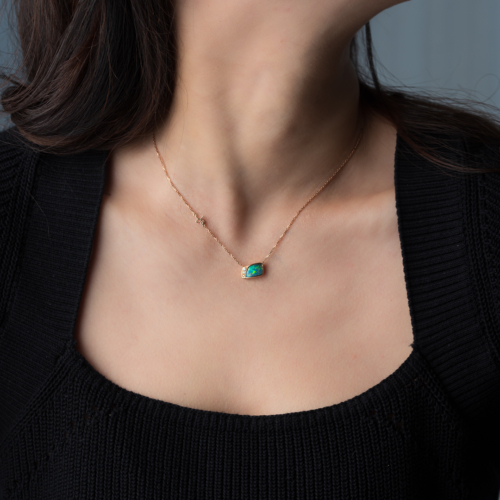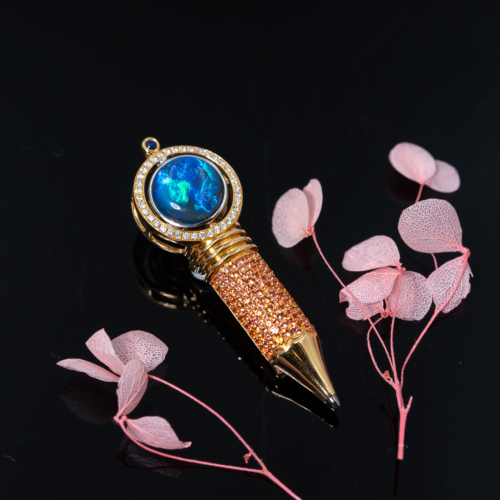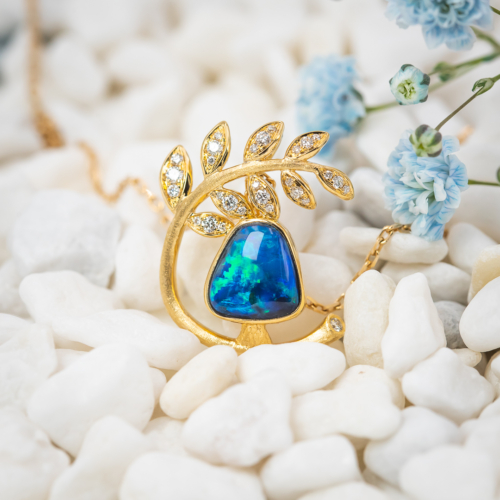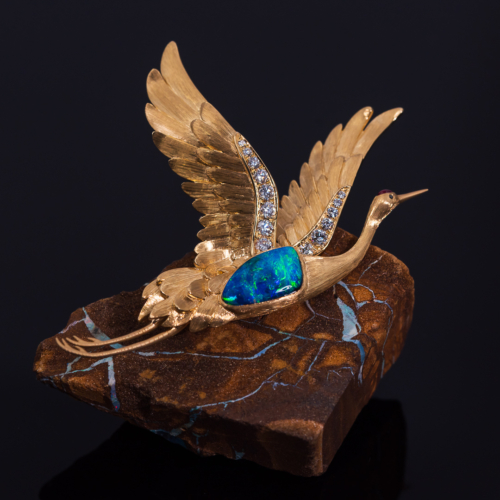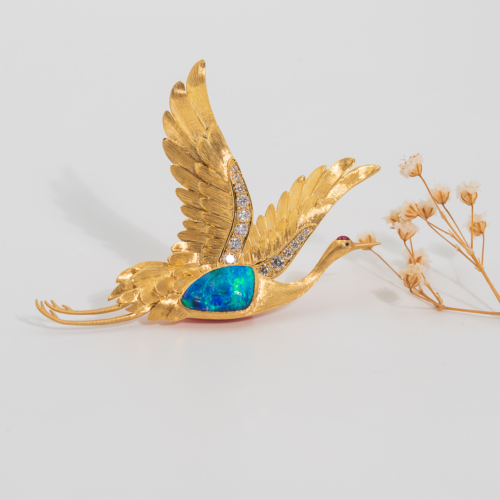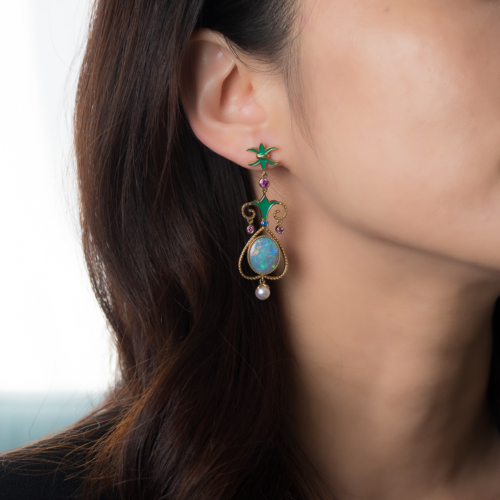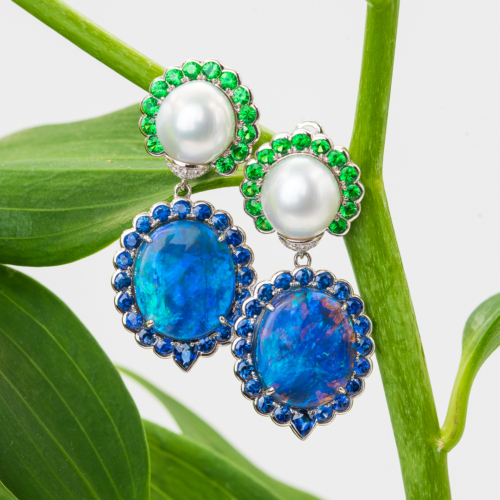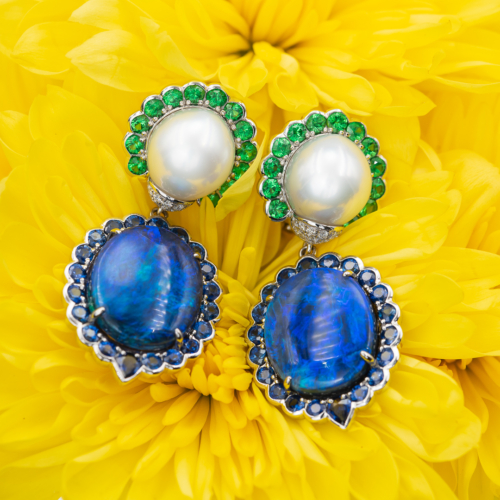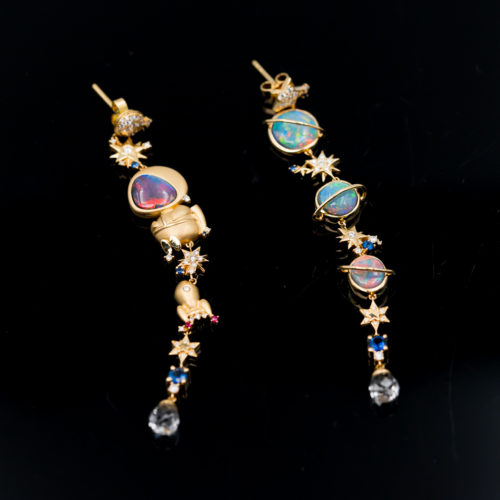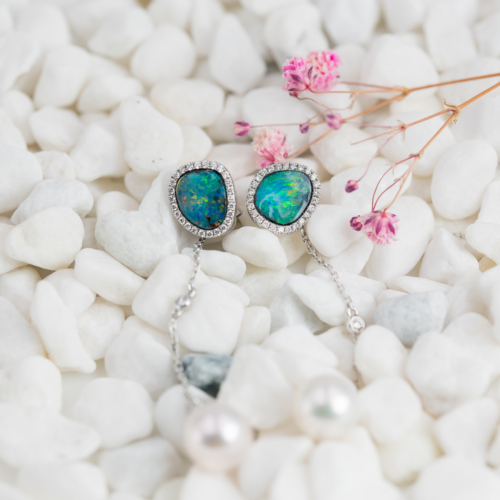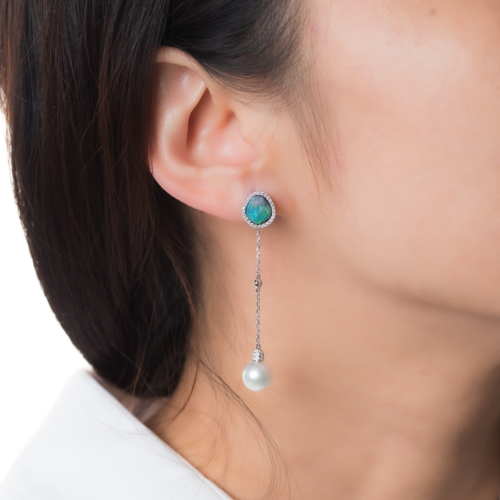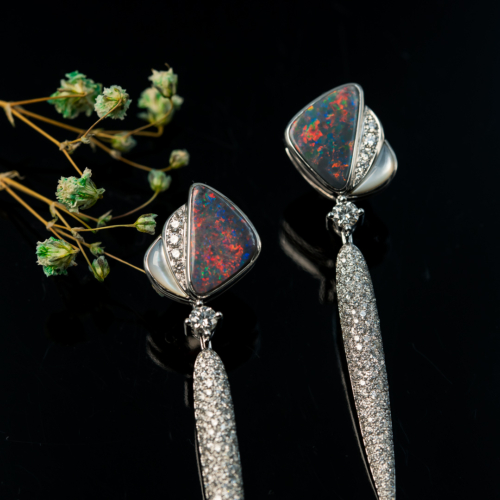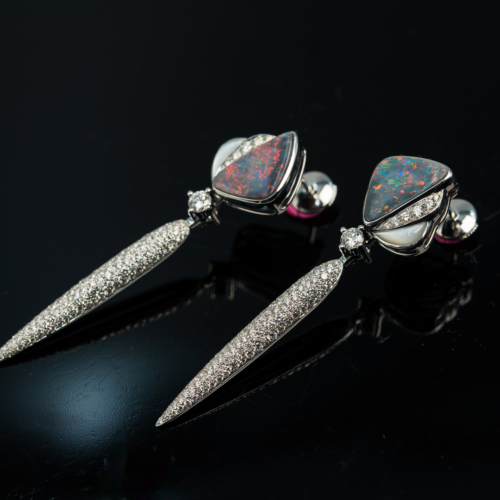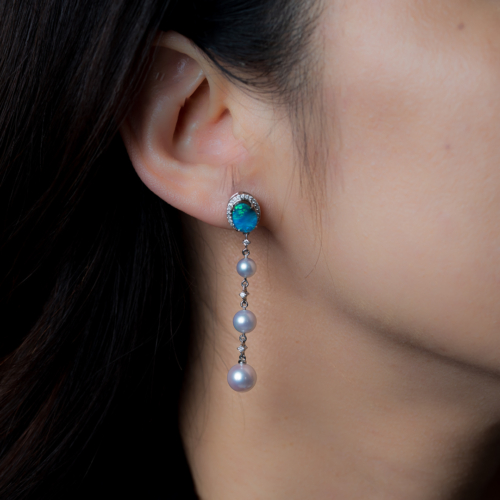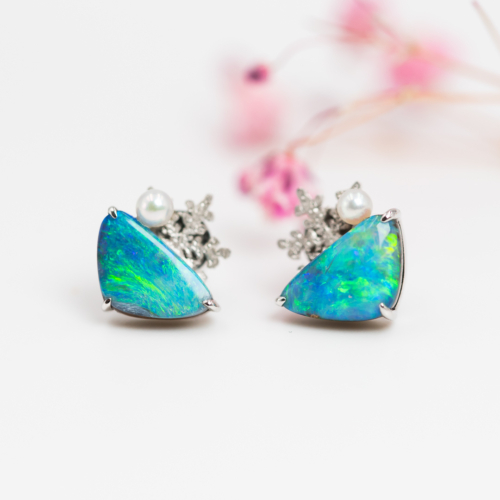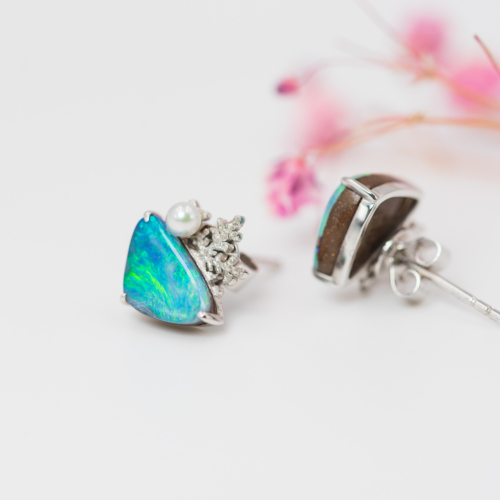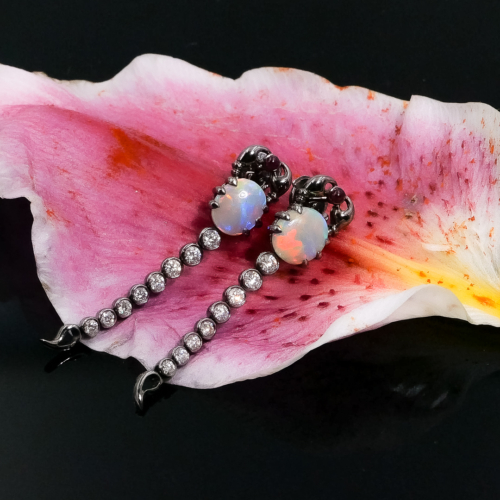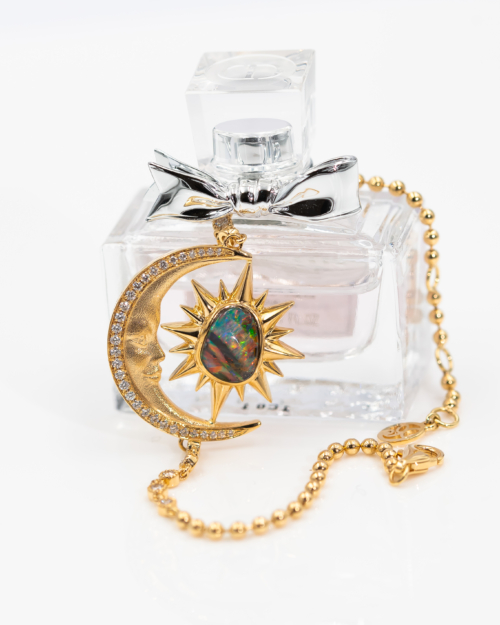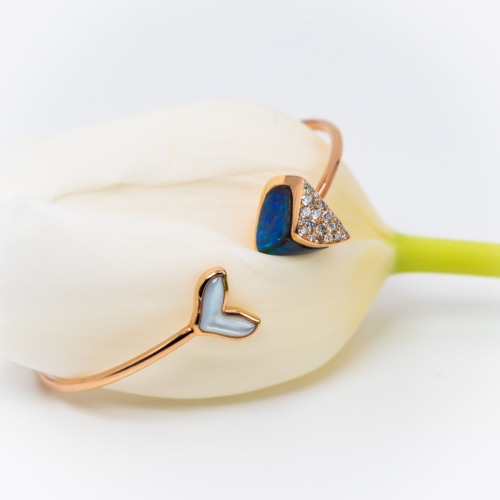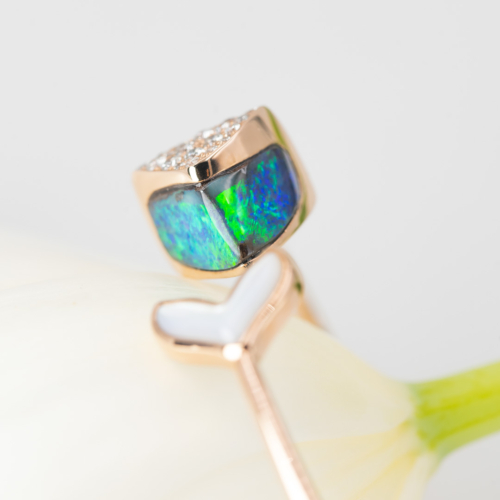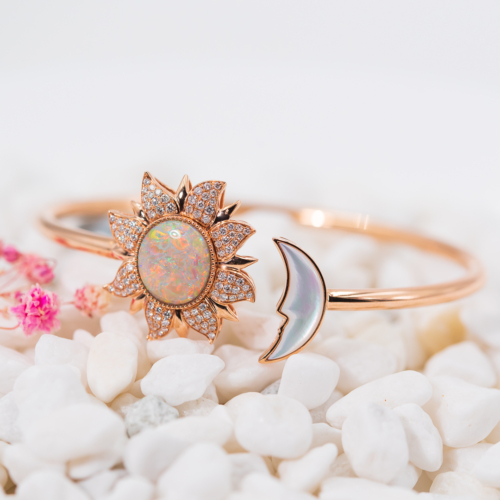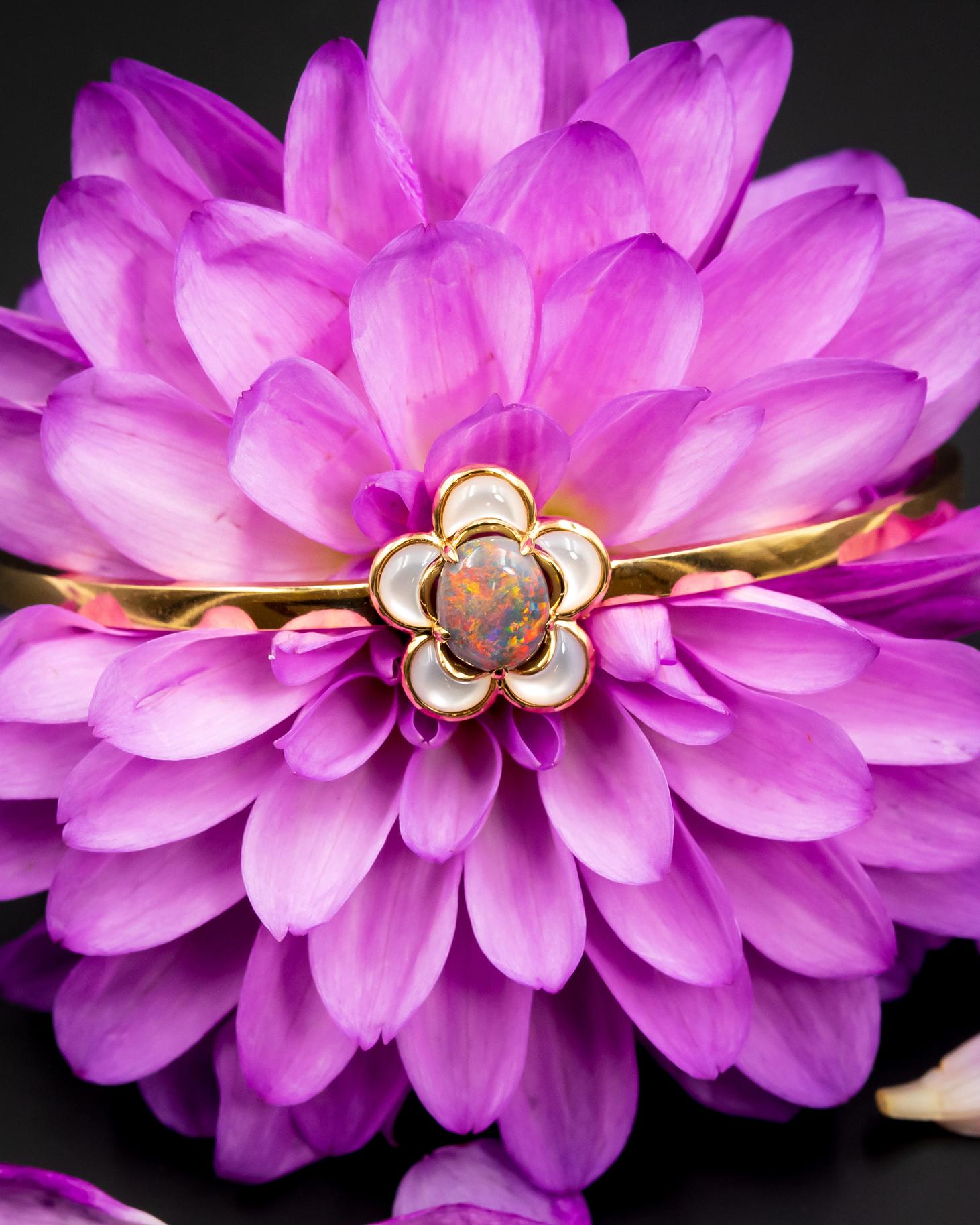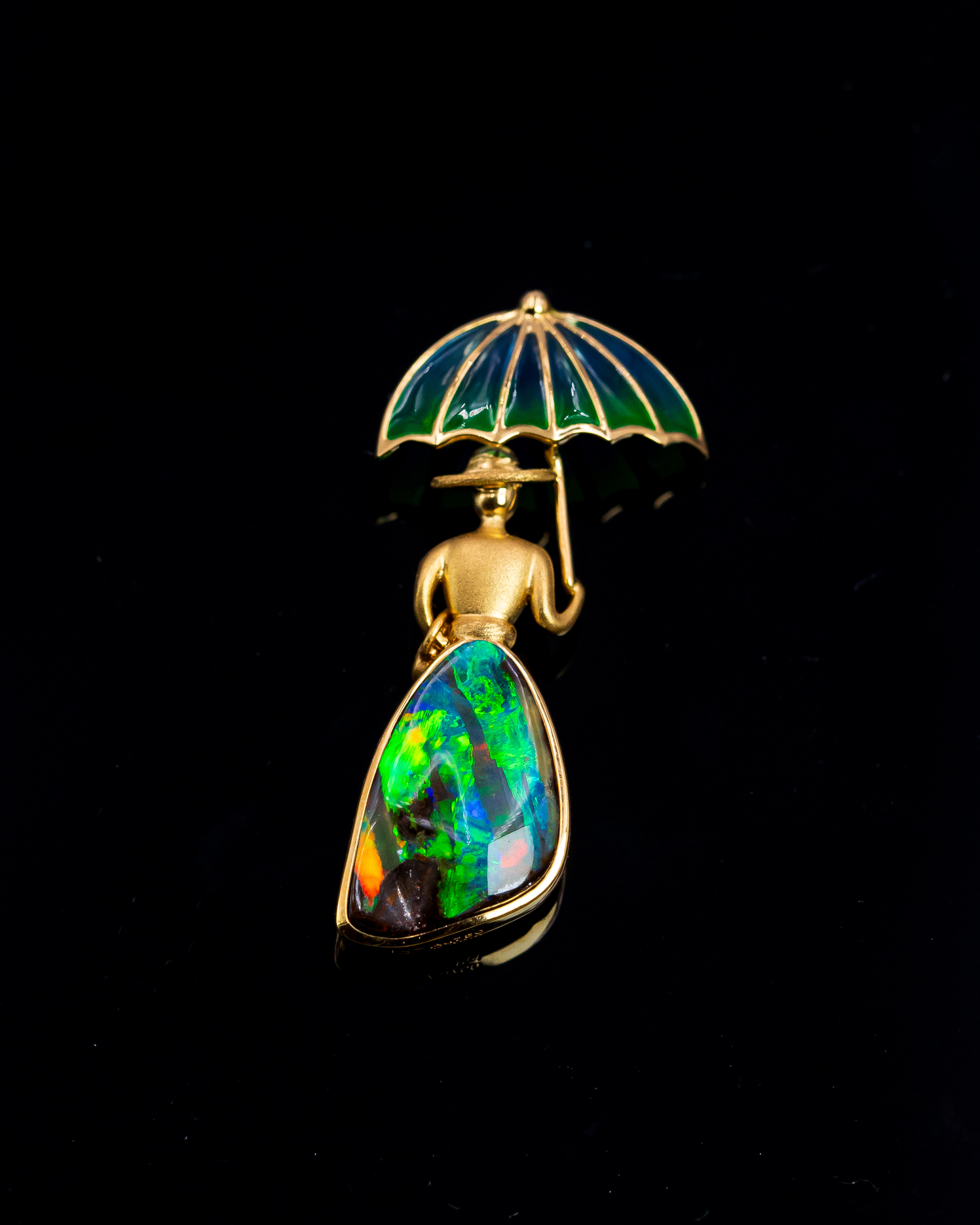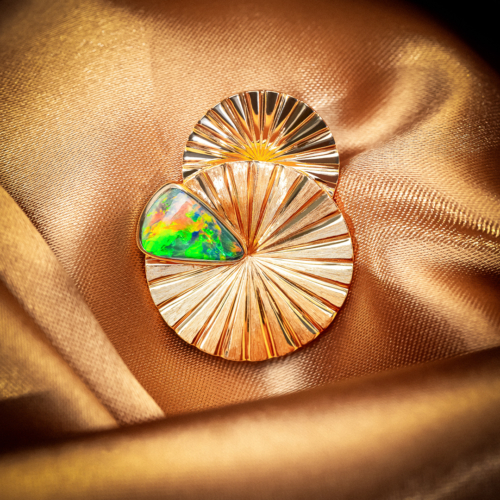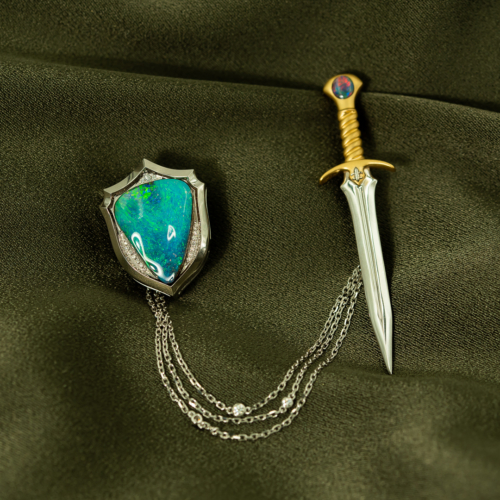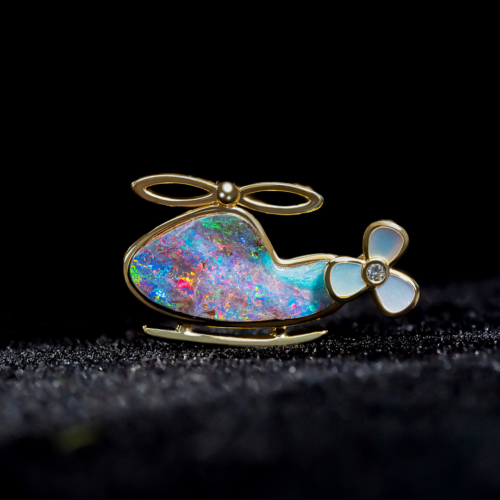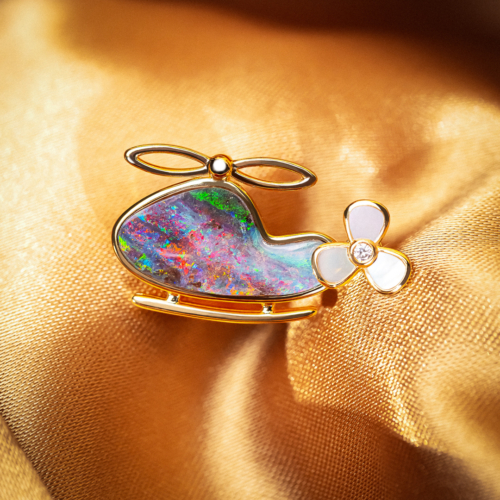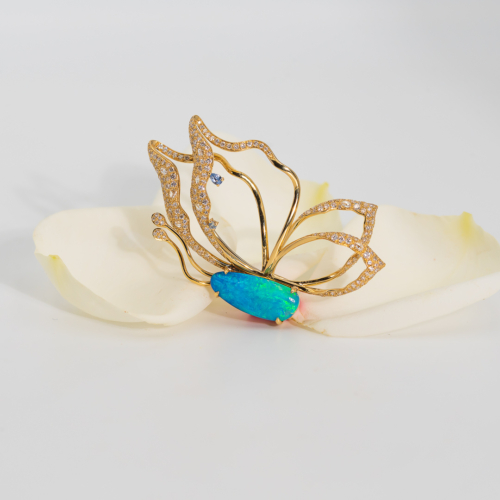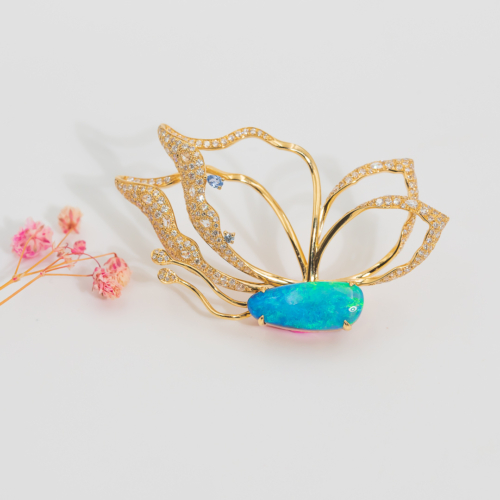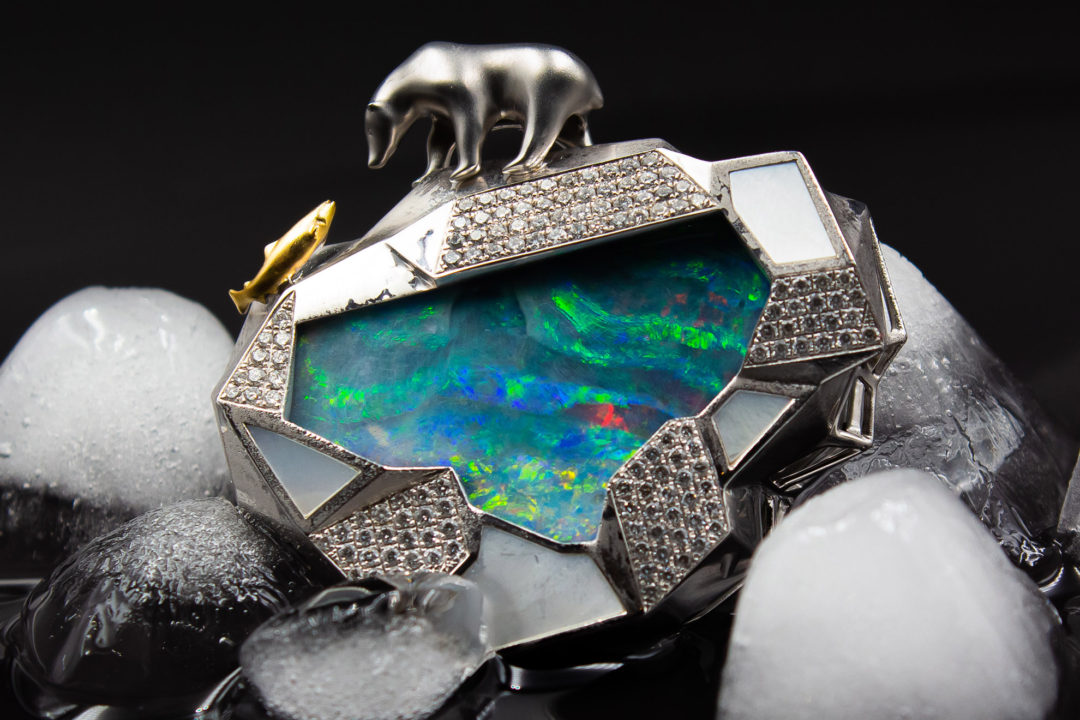
Opal guide
The Ultimate Opal Jewellery Guide
By Cindy Xu Jewellery editorial team. Updated 2023
Opal jewellery guide overview
Discover everything you need to know about opal jewelry in this comprehensive opal jewellery guide. We’ve gathered all the essential information to empower you to confidently pick the best opal jewelry with ease and assurance.
Nature’s living kaleidoscope
Opals, often hailed as nature’s living kaleidoscope, are among the most intriguing gemstones to grace the Earth. Their enchanting play of colors, known as “play-of-color,” is a captivating phenomenon that has fascinated gem enthusiasts for centuries. As light dances across their surface, opals exhibit a mesmerizing interplay of vibrant hues, from fiery reds and electric blues to tranquil greens and deep purples.
People have prized the beauty of opals for centuries. They were first used in jewellery by the ancient Greeks and Romans. During the Middle Ages, people believed in the magical powers of opals, contributing to their popularity. In the Victorian era, opal jewellery gained even more popularity, with opal engagement rings and other fine jewellery frequently utilized. Opals symbolized hope, good luck, and love.
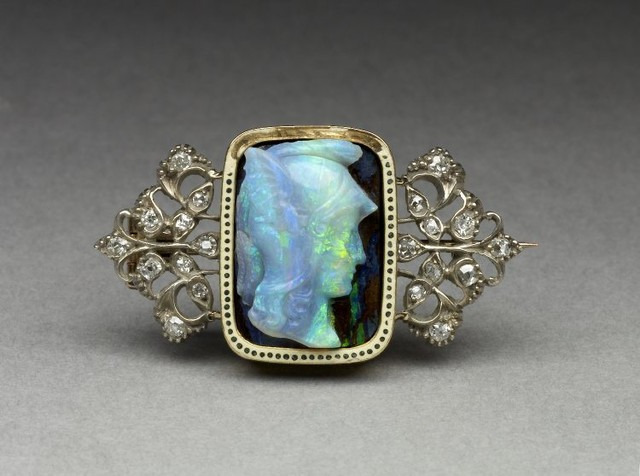
Opal cameo of helmeted warrior attributed to Wilhelm Schmidt. In a diamond set enameled setting, Marked C&AG for C & A Giuliano, circa 1895. English. Ref Collection of the British Museum.
Opals are significant in the jewellery world because of their unique beauty and rarity. They are also a symbol of hope and good luck. People often give opals as gifts to celebrate special occasions like weddings and anniversaries. They use opals in a wide variety of pieces, including engagement rings, necklaces, earrings, and bracelets. Opals are also incorporated into some types of watches and other accessories.
Opals are unique in several ways. First, they are the only gemstone that exhibits a play of color. Second, opals are relatively soft, which means that they are more delicate than other gemstones, such as diamonds and sapphires. Third, Opals can have a wide range of appearances because they are formed in a variety of geological environments.
Why invest in opal jewellery
Investing in opal jewellery can be an intriguing and potentially lucrative venture for several compelling reasons. Firstly, opals are renowned for their captivating play of colors, which makes them highly sought after by collectors and enthusiasts alike. Their unique aesthetic appeal and rarity contribute to their desirability. Additionally, opals have a rich cultural and historical significance, which further enhances their allure.
As opal mines become increasingly depleted, the value of high-quality opal jewellery is expected to appreciate over time, potentially yielding substantial returns on investment. Moreover, opal Jewellery is not only an asset but also a wearable work of art, allowing investors to enjoy its beauty while potentially benefiting from its increasing value. However, it’s crucial for investors to conduct thorough research, seek expert guidance, and ensure the authenticity and quality of the opal before making a purchase.
In addition to these general reasons, there are also a number of financial reasons to invest in opal jewellery .
- Opals have a history of appreciating in value. Over the past few decades, the value of opals has increased significantly. This is likely to continue in the future, as the supply of opals becomes more limited and the demand for them increases.
- Opals are a good hedge against inflation. As the cost of living increases, the value of opals is also likely to increase. This makes them a good way to protect your wealth over time.
- Opals are a portable and liquid asset. They can be easily transported and sold, making them a good investment for people who are often on the move.
How are opals created?
Opals, cherished for their captivating array of colors, possess an origin story that is as intriguing as the gemstones themselves. It is a narrative woven through millions of years, a choreography of water and minerals deep within the Earth’s crust.
Deep within the Earth’s crust, a complex interplay of geological activity and water movement creates concealed voids and crevices. These hollows serve as the cradles for the formation of opals, providing the necessary space for this extraordinary process.

The role of silica spheres
Silica, a ubiquitous mineral, takes center stage in opal formation. Over vast stretches of time, water laden with dissolved silica seeps into these subterranean chambers. As the water gradually evaporates, it leaves behind minuscule spheres composed of silica. In a remarkable display of natural precision, these silica spheres arrange themselves in an organized fashion. Picture a grand assemblage of marbles, each one finding its perfect place in the stack.
The radiant play of colors
Opals are renowned for their captivating “play of color.” This captivating effect arises from the infinitesimal gaps between the silica spheres. As light enters, it undergoes refraction and reflects off these gaps, resulting in a spectacular spectrum of colors. It’s akin to a dazzling fireworks show encapsulated within the heart of the gemstone!
Due to this intricate interplay of spheres and light, each opal emerges as a one-of-a-kind masterpiece, featuring its own distinct arrangement of colors and patterns. This individuality is what makes opals truly extraordinary.
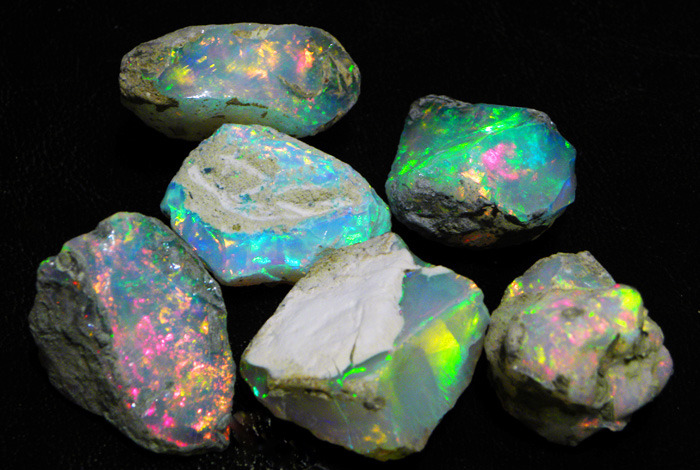
Where do opals come from?
Australia the opal nexus
Opals, Earth’s iridescent treasures, trace their origins to the sunburnt lands of Australia, a continent steeped in geological marvels and ancient history. Holding a staggering 95% share of the world’s opal production, Australia rightfully claims its title as the global epicenter of opal mining. Here, beneath the vast, sun-drenched landscapes, lies a hidden palette of colors, patiently awaiting discovery and admiration.
Lightning Ridge – the realm of black opals
🌏 Location: Situated in New South Wales, Lightning Ridge reigns as the premier destination for Australian black opals worldwide.
✨Geological Significance: This region harbors unique geological formations, including the famous ‘Grawin Opal Field,’ known for its high-quality black opals formed in ancient marine sediment.
⛏ Mining Legacy: Lightning Ridge has a history of opal mining, with operations dating back to the late 1800s. The region is renowned for producing some of the world’s most coveted black opal stone, prized for their vibrant play of colors.

Coober Pedy – haven of white opals
🌏 Location: Nestled in South Australia, Coober Pedy stands as a bastion for white opals, revered for their ethereal luminescence.
✨ Geological Marvels: The opal fields here are set amidst the ancient seabed, where silica-rich solutions solidified over millions of years, giving rise to the opal-bearing layers.
⛏ Innovative Mining Techniques: Coober Pedy is known for its unique ‘opal noodling’ method, where miners scour the surface for exposed opals, a testament to the region’s rich opal deposits.

Global opal producers
While Australia stands as the unrivaled leader in opal production, other countries contribute to the global opal market:
Ethiopia
Known for its vibrant, hydrophane opals, Ethiopia has emerged as a significant player in the opal industry. The Wollo Province, specifically, is celebrated for its fiery, high-quality opals.
Brazil
Brazil, particularly the Quixaba region, is recognized for producing opals with exceptional clarity and vivid color play. The country’s opal industry continues to grow, catering to a discerning global market.
United States
Nevada’s Virgin Valley and Oregon’s Opal Butte are noteworthy opal-producing regions. Virgin Valley, known for its precious black opals, and Opal Butte, famous for its dazzling crystal opals, contribute to the diverse global opal market.
How are opals in opal jewellery cut?
The opal-cutting process typically involves the following steps:
- Rough cutting: The rough opal is cut into a basic shape using a diamond saw.
- Pre-forming: The opal is pre-formed into a more specific shape using a variety of tools, such as grinders and files.
- Polishing: The opal is polished to a high shine using a variety of polishing wheels and compounds.

There are a variety of opal cutting techniques that can be used to create different shapes and finishes. Some of the most common opal-cutting techniques include:
Cabochon – A cabochon is a smooth, rounded gemstone that has a convex surface. Cabochons are a popular choice for opals because they showcase the gemstone’s play of color to the best advantage.
Faceted – A faceted gemstone is cut with a series of flat planes that reflect light. Faceted opals are less common than cabochon opals, but they can be very beautiful.
Beads – Opal beads are made by cutting opals into small, round spheres. Opal beads are popular for use in jewellery, such as necklaces and bracelets.
Carvings – Opals can also be carved into intricate shapes and designs. Opal carvings are often used in high-end jewellery.
Factors to consider when cutting opals
- The color and pattern of the opal will determine how the gemstone is cut. For example, a cabochon cut is often chosen for opals with a bright play-of-color, while a faceted cut may be chosen for opals with a more subtle play-of-color.
- The size of the opal will also determine how it is cut. For example, a large opal may be cut into a cabochon or a faceted stone, while a small opal may be cut into a bead or a carving.
- The quality of the opal will also determine how it is cut. For example, a high-quality opal may be cut into a cabochon or a faceted stone, while a lower-quality opal may be cut into a bead or a carving.
Variety of opals and costs
There are many different varieties of opals, each with its own unique appearance. Let’s delve into five prominent opal types, along with their respective price ranges in Australian Dollars (AUD).

White opals – subtle elegance with surprising affordability
Price Range: 💲💲
White opals, known for their pale body colors, are an affordable option for opal enthusiasts. Sourced primarily from South Australia, particularly the opal-rich fields in Coober Pedy, these opals offer an accessible entry point into the world of opal jewellery. Their affordability makes them an attractive choice for both collectors and those looking for elegant yet budget-friendly options.
Boulder opals – nature’s artistry in stone
Price Range: 💲💲💲
Boulder opals, formed within ironstone boulders, are a testament to nature’s artistry. The Quilpie-Winton region in Queensland, Australia, is the primary source. Due to their unique formation, boulder opals can be pricier than other varieties. However, the striking patterns and colors they exhibit make them a worthy investment for collectors seeking distinctive and visually stunning pieces.

Black opals – the epitome of opal splendor
Price Range: 💲💲💲💲
Black opals, with their dark body tones, provide a dramatic canvas for their vibrant play of colors. Lightning Ridge in New South Wales, Australia, is the world-renowned source for black opal jewlery. These opals command a premium price due to their rarity, with only 1% of Lightning Ridge opals being black [source: Gemological Institute of America]. Their unparalleled visual impact makes them the pinnacle of opal desirability.
Crystal opals – nature’s translucent masterpieces
Price Range: 💲💲💲
Crystal opal, known for their transparency and brilliance, are sourced primarily from Coober Pedy, South Australia. Their semi-translucent body allows light to pass through, intensifying their play of colors. While they are more affordable than black opals, their clarity and dazzling visual effects still make them highly sought after among collectors and jewellery designers.
Fire opals – a blaze of warmth from Mexican soil
Price Range: 💲💲
Fire opals, named for their fiery hues, emanate warmth reminiscent of a Mexican sunset. The state of Jalisco in Mexico, particularly the Magdalena-Querétaro region, is the principal source. These opals offer an affordable option for those captivated by their intense coloration and captivating brilliance.
In conclusion, opals offer a breathtaking array of colors and patterns, with each variety catering to different tastes and budgets. Whether you’re drawn to the subtle elegance of white opals or the intense splendor of black opals, there’s an opal variety for every enthusiast. Delving into the world of opals promises a rewarding journey, where you can find a unique gemstone that resonates with you.
How to evaluate opal jewellery quality
When evaluating opal jewellery quality, it is important to consider the following factors:
Body color
When it comes to valuing black opal, the color of its background is crucial. A black or dark-toned background is rarer and more valuable than a light or crystal-toned one. This dark background often enhances the richness of colors on the surface.
The more vibrant the colors with a darker background, the more desirable the opal is. The highest quality is designated as N1.

Black Opal: This type of opal displays a play-of-color on a black body tone. This is determined by referencing the AGIA Body Tone Chart with categories N1, N2, N3, and N4 when viewed face up.
Dark Opal: Dark opal showcases a play-of-color on a dark body tone. This is determined by referencing the AGIA Body Tone Chart with categories N5 and N6 when viewed face up.
Light Opal: Light opal features a play-of-color on a light body tone. This is determined by referencing the AGIA Body Tone Chart with categories N7, N8, or N9 when viewed face up. The N9 category is commonly referred to as white opal.
If an opal has a distinct colored body, like yellow, orange, red, or brown, it should be classified as either black, dark, or light opal, using the AGIA Body Tone Chart as a reference. Additionally, a note should be added to indicate its color hue.
Opal’s play of color
Opal is prized for its play of color, which is the phenomenon of multiple colors being displayed when the gem is viewed from different angles. The more colors present, the higher the quality of the opal. The most valuable opals are those that display a wide range of colors, including red, orange, and green.

Opal is a unique gemstone known for its mesmerizing play of color. This phenomenon occurs when light diffracts off the tiny silica spheres that make up the opal. The play of color can vary widely, displaying a dazzling spectrum of hues, including red, orange, yellow, green, blue, purple, and pink.
The play of color is the most important factor to consider when evaluating opal. A high-quality opal will have a bright and vibrant play of color, with a wide range of colors present. The more colors present, the higher the value of the opal.
The play of color can also be affected by the opal’s body tone. Opals with a light body tone, such as white or pale yellow, tend to display a brighter and more vibrant play of color than opals with a dark body tone, such as black or brown.
Inspect the opal from different angles. The play of color will vary depending on the angle from which the opal is viewed. Look for an opal that has a bright and vibrant play of color from all angles.
Compare the opal to other opals. This will help you to see how the opal’s play of color compares to other opals on the market.
Clarity
Opal clarity is all about how clear and transparent the opal is. It can range from see-through to not see-through at all. Different opal types are valued for different levels of clarity. For instance, crystal opals look best when they’re very clear, while black opals look great when they’re not very clear. The background of the opal affects how its colors show, so it’s important. Opals with a cloudy or milky background are not as valuable because they don’t look as good and might not be as strong.
Opals, like other gems, can sometimes have marks or spots on them. They might also have bits of the rock they formed in, called matrix. Sometimes, having matrix is not good for the opal’s look and value, but it depends on the type of opal.
If an opal dries out, it can get little cracks that look like a spider’s web. This is called crazing. It happens from things like heat, dryness, or too much light. To keep opals safe, don’t put them in places where these things can happen, like in a bright window.
Cut
Opal’s cut is a crucial aspect of bringing out its inherent beauty and brilliance. Skilled lapidaries, or gemstone cutters, employ precision tools and techniques to reveal the opal’s play of color to its fullest potential. Unlike traditional faceted gemstones, opals are typically cut into cabochons, which are smooth, polished, and rounded shapes without facets.
The choice of cabochon cut is deliberate, as it allows the lapidary to maximize the surface area through which the play of color can be observed. A well-executed cabochon cut ensures that the opal’s colors are evenly distributed and easily visible. The shape of the cabochon can vary, with oval, round, and pear shapes being among the most popular. The goal is to enhance the opal’s natural beauty while also creating a pleasing overall form.
Setting
The setting of the opal in jewellery can also affect its overall appearance. A well-designed setting should secure the opal firmly while allowing maximum light exposure. Additionally, the design should complement the opal’s natural beauty.
In addition to these factors, it is also important to consider the ethical sourcing of the opal. Opals are mined in a variety of locations around the world, but Australia is the world’s leading producer. Opals from Australia are typically mined in a sustainable and ethical manner. When purchasing opal jewellery, it is important to ask the jeweler about the origin of the opal and whether it has been treated in any way.
Here are some additional tips for evaluating opal jewellery quality:
- Inspect the opal carefully for any damage or flaws. Look for cracks, chips, and inclusions.
- Hold the opal up to the light and look for the play of color. The more colors present, the higher the quality of the opal.
- Ask the jeweler about the opal’s origin and whether it has been treated in any way.
- Compare the prices of different pieces of opal jewellery. Opals can vary widely in price depending on their quality, size, and rarity.
Remember, the best way to evaluate opal jewellery quality is to trust your own eyes and instincts. Choose the opal that you find most beautiful and that speaks to you.
Opal jewellery styles
Opal jewellery comes in a variety of styles, each showcasing the mesmerizing play of colors unique to this gemstone. Understanding the different styles can help you choose a piece that complements your personal taste and lifestyle. Here are some popular types of opal jewellery styles.
Opal rings
Opal rings are a timeless choice, adorning fingers with the captivating hues of this gemstone. They come in various designs, from classic solitaire settings to intricate multi-stone arrangements. Australian Opal rings can feature different types of opals, such as black opal ring, white opal ring, blue opal ring or boulder opal ring, each with its own distinct play of color. Australian black opal ring from lighting ridge are highly sought after.
Opal engagement rings – a symbol of love and uniqueness
Australian opal engagement rings are a unique and beautiful way to propose to your loved one. Black opal engagement rings are particularly popular, as they offer a deep and mysterious look. Black opals are the rarest and most valuable type of opal, and they are known for their vibrant play of color.
Opal and diamond engagement rings are another popular choice, as they combine the beauty of opals with the sparkle of diamonds. A variety of styles can be found, from simple solitaire rings to more elaborate designs.
Opal pendants and opal necklace
An opal pendant necklace is an elegant piece that hangs from a chain around the neck. They showcase the opal’s brilliance and are often chosen for their versatility and ability to complement various outfits. Gold opal necklace can be simple and understated or elaborate and ornate, depending on the design and setting. Australian Opal necklace can feature different varieties, such as black opal necklace, white opal necklace, blue opal necklace, boulder opal pendant, or black opal pendant.
Opal earrings
Gold opal earrings add a touch of elegance to any ensemble. They come in various styles, including opal drop earrings, opal studs, opal dangle earrings, and opal hoops earrings. Opal studs are particularly popular for their simplicity and versatility, while opal dangle earrings showcase the gemstone’s movement and play of color. Australian Opal earrings can feature different varieties, such as black opal earrings, white opal earrings, blue opal earrings or boulder opal earrings.
Opal bracelets
Opal bracelets feature opal gemstones set into a band, creating a stunning display of colors around the wrist. They can be crafted with a single type of opal or a combination of different opals for a unique and eye-catching look.
Opal brooches
Opal brooches are versatile accessories that can be pinned to clothing or accessories, adding a touch of opalescent charm. They often feature opals in combination with other gemstones or metals, creating intricate and eye-catching designs. At Cindy Xu jewelry many opal brooches designed by Cindy can also to transformed into opal pendants and attached to a necklace.
Whether you’re drawn to the elegance of opal rings, the versatility of opal pendants, or the charm of opal earrings, At Cindy Xu jewelry we have a style to suit every taste and occasion. When choosing opal jewellery, consider the type of opal, setting, and design that resonates with you, and you’ll have a piece that embodies the captivating beauty of this remarkable gemstone.
How to care for opal jewellery
Caring for opal jewellery is essential to preserve its stunning beauty and ensure its longevity. Opals are relatively delicate gemstones, so they require special attention to keep them looking their best. Here are some crucial tips for opal jewellery care.
Avoid harsh chemicals
Opals are sensitive to chemicals, which can damage their surface and affect their play of color. It’s crucial to avoid exposing opals to household chemicals, such as bleach, ammonia, and other cleaning agents. Additionally, avoid wearing opal jewellery while applying lotions, perfumes, or hairspray.
Gentle cleaning
To clean opal jewellery, use a mild detergent mixed with warm water and a soft brush, like a toothbrush. Gently scrub the surface of the opal, being careful not to apply too much pressure. Rinse thoroughly with clean water and pat dry with a soft cloth. Avoid using ultrasonic or steam cleaners, as they can potentially damage the opal.
Store separately
When not wearing your opal jewellery, store it separately from other pieces to prevent scratching. Consider using individual pouches or jewellery boxes with compartments to keep each piece protected.
Avoid extreme temperatures
Opals are sensitive to sudden temperature changes. Avoid exposing them to extreme heat or cold, as it can lead to cracks or crazing. For example, don’t wear opal jewellery while swimming in hot tubs or when engaging in activities that involve rapid temperature fluctuations.
Limit sun exposure
Prolonged exposure to direct sunlight can cause opals to become dehydrated and lose their play of color. Avoid leaving opal jewellery in direct sunlight for extended periods. When storing opal jewellery, consider keeping it in a jewellery box or drawer away from windows.
By following these care tips, you can ensure that your opal jewellery retains its natural beauty and continues to be a cherished piece for generations to come. Remember, treating opals with care and respect will allow you to enjoy their captivating play of color for years to come.
An opal jewellery buyer’s guide summary
In closing, opal jewellery offers a captivating blend of history, rarity, and natural beauty. As a potential buyer, understanding key factors like body color, play of color, clarity, cut, and setting is crucial. Additionally, caring for opal jewellery with gentle cleaning and proper storage ensures its longevity. It’s essential to choose opals that resonate with your personal style and preferences. Whether you’re drawn to the subtle elegance of white opals or the intense splendor of black opals, each variety has its own unique charm. This guide serves as a valuable tool to make informed decisions and select opal jewellery that will not only be a cherished adornment but also a timeless investment in nature’s extraordinary artistry. Happy shopping!
References
- Roberts, A., & Gough, L. (2007). Opal Formation in the Great Artesian Basin, Australia: Implications from a Stable Isotope Investigation. Economic Geology, 102(4), 717-738.
- Hofmeister, W., & Rossman, G. R. (1985). The role of water in the tensile deformation of opal. Geophysical Research Letters, 12(10), 693-696.
- Klug, D. D., & Ebanks, W. J. (1993). An infrared spectroscopic study of opal in cherts and siliceous shale: variations in formation and crystallinity. American Mineralogist, 78(3-4), 391-405.
- Fetherston, J. (2019). Lightning Ridge Opal Mines. Gemmological Association of Australia.
- National Opal Collection. (2021). Opals of the World.
- Bosshart, G. (2017). Opal: Identification & Value. AccArt Books.
- GIA. (2021). Opal Quality Factors.
- Gem Society. “Opal Jewelry and Gemstone Information.” https://www.gemsociety.org/article/opal-jewelry-and-gemstone-information/
- Gemological Institute of America. “Opal Identification and Value.” John Sinkankas, 1997.
- American Museum of Natural History: http://naturalhistory.si.edu/explore/collections/geogallery/10026345
Table of Contents




